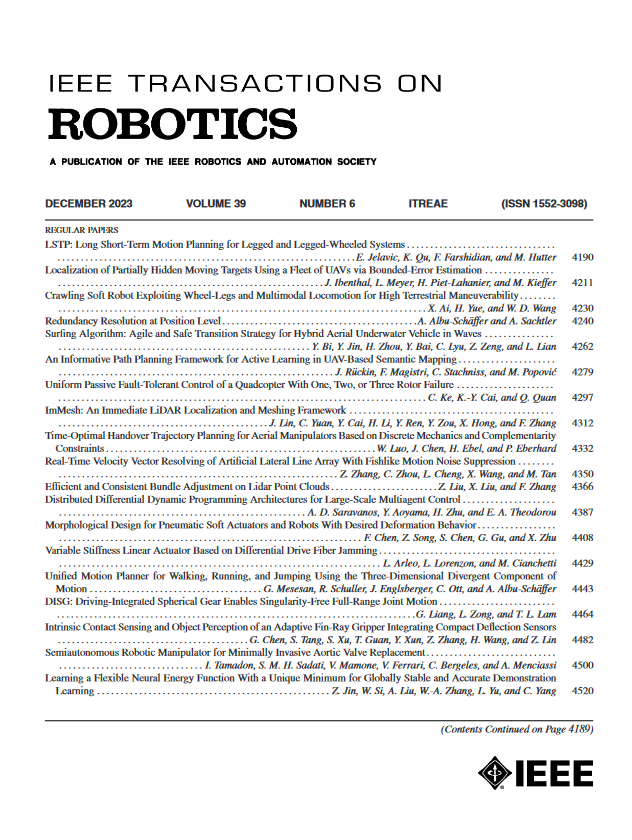ProxDDP: Proximal Constrained Trajectory Optimization
IF 10.5
1区 计算机科学
Q1 ROBOTICS
引用次数: 0
Abstract
Trajectory optimization has been a popular choice for motion generation and control in robotics for at least a decade. Several numerical approaches have exhibited the required speed to enable online computation of trajectories for real-time of various systems, including complex robots. Many of these said are based on the differential dynamic programming (DDP) algorithm—initially designed for unconstrained trajectory optimization problems—and its variants, which are relatively easy to implement and provide good runtime performance. However, several problems in robot control call for using constrained formulations (e.g., torque limits, obstacle avoidance), from which several difficulties arise when trying to adapt DDP-type methods: numerical stability, computational efficiency, and constraint satisfaction. In this article, we leverage proximal methods for constrained optimization and introduce a DDP-type method for fast, constrained trajectory optimization suited for model-predictive control (MPC) applications with easy warm-starting. Compared to earlier solvers, our approach effectively manages hard constraints without warm-start limitations and exhibits good convergence behavior. We provide a complete implementation as part of an open-source and flexible C++ trajectory optimization library calledPROXDDP:近端约束轨迹优化
轨迹优化已经成为机器人运动生成和控制的热门选择至少有十年了。几种数值方法已经显示出所需的速度,以便能够在线计算各种系统的实时轨迹,包括复杂的机器人。其中许多都是基于差分动态规划(DDP)算法(最初是为无约束轨迹优化问题设计的)及其变体,这些算法相对容易实现并提供良好的运行时性能。然而,机器人控制中的一些问题需要使用约束公式(例如,扭矩限制,避障),当试图采用ddp类型的方法时,会出现一些困难:数值稳定性,计算效率和约束满足。在本文中,我们利用近端方法进行约束优化,并引入了一种ddp类型的方法,用于快速、约束轨迹优化,适用于具有容易热启动的模型预测控制(MPC)应用。与以前的求解方法相比,我们的方法有效地管理了硬约束,没有热启动限制,并表现出良好的收敛性。我们提供了一个完整的实现,作为开源和灵活的c++轨迹优化库aligator的一部分。通过机器人文献中的几个轨迹规划场景和四足机器人的实时全身MPC,验证了这些算法的贡献。
本文章由计算机程序翻译,如有差异,请以英文原文为准。
求助全文
约1分钟内获得全文
求助全文
来源期刊

IEEE Transactions on Robotics
工程技术-机器人学
CiteScore
14.90
自引率
5.10%
发文量
259
审稿时长
6.0 months
期刊介绍:
The IEEE Transactions on Robotics (T-RO) is dedicated to publishing fundamental papers covering all facets of robotics, drawing on interdisciplinary approaches from computer science, control systems, electrical engineering, mathematics, mechanical engineering, and beyond. From industrial applications to service and personal assistants, surgical operations to space, underwater, and remote exploration, robots and intelligent machines play pivotal roles across various domains, including entertainment, safety, search and rescue, military applications, agriculture, and intelligent vehicles.
Special emphasis is placed on intelligent machines and systems designed for unstructured environments, where a significant portion of the environment remains unknown and beyond direct sensing or control.
 求助内容:
求助内容: 应助结果提醒方式:
应助结果提醒方式:


